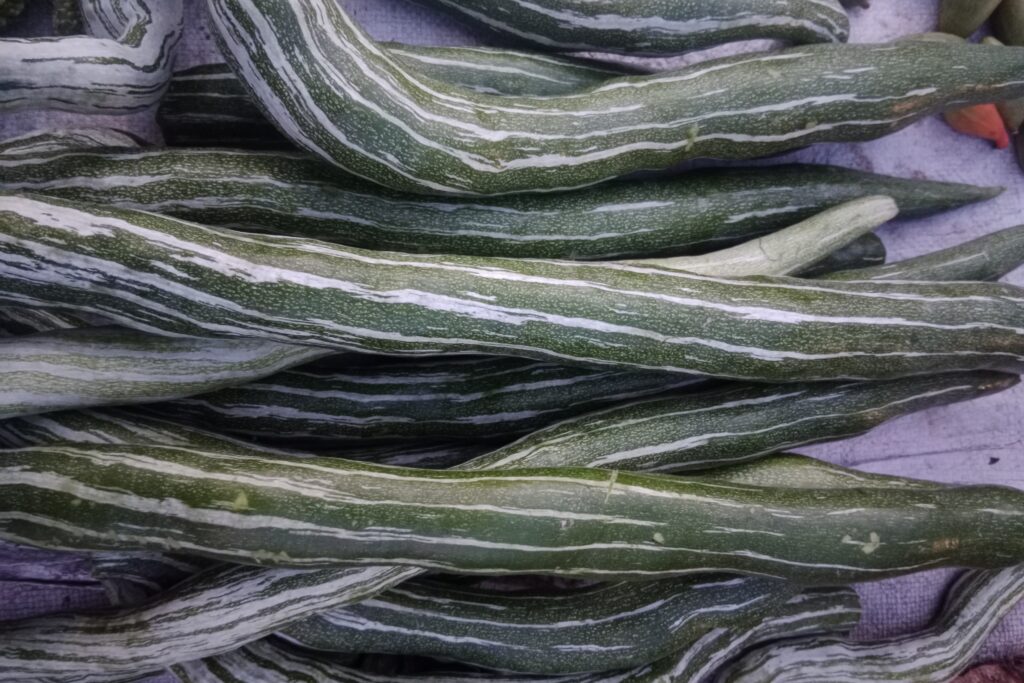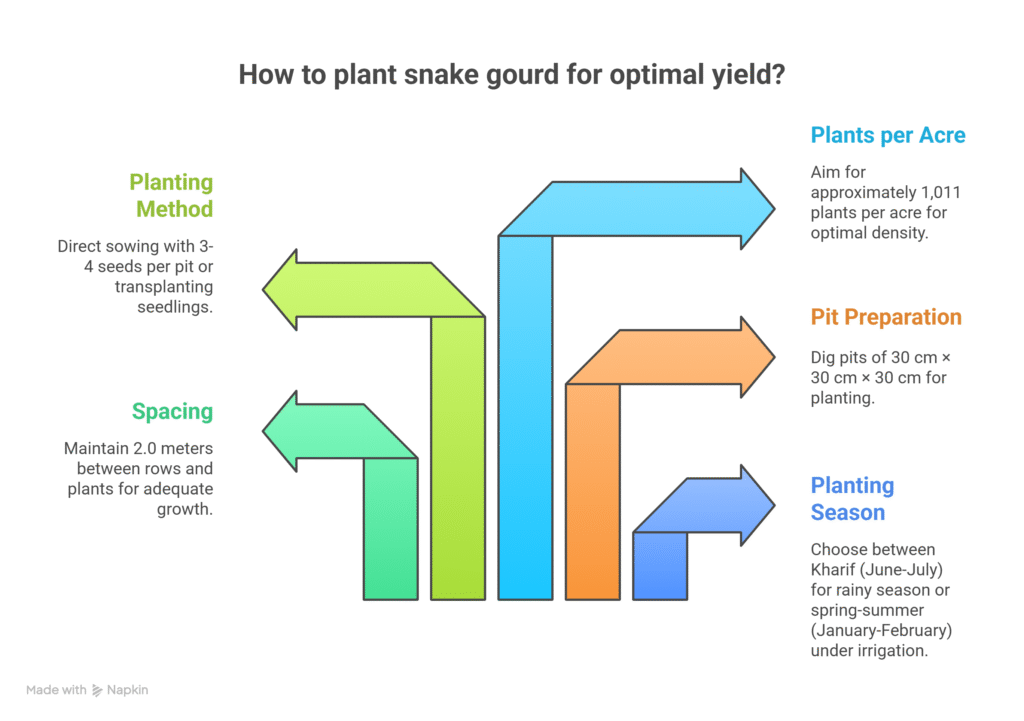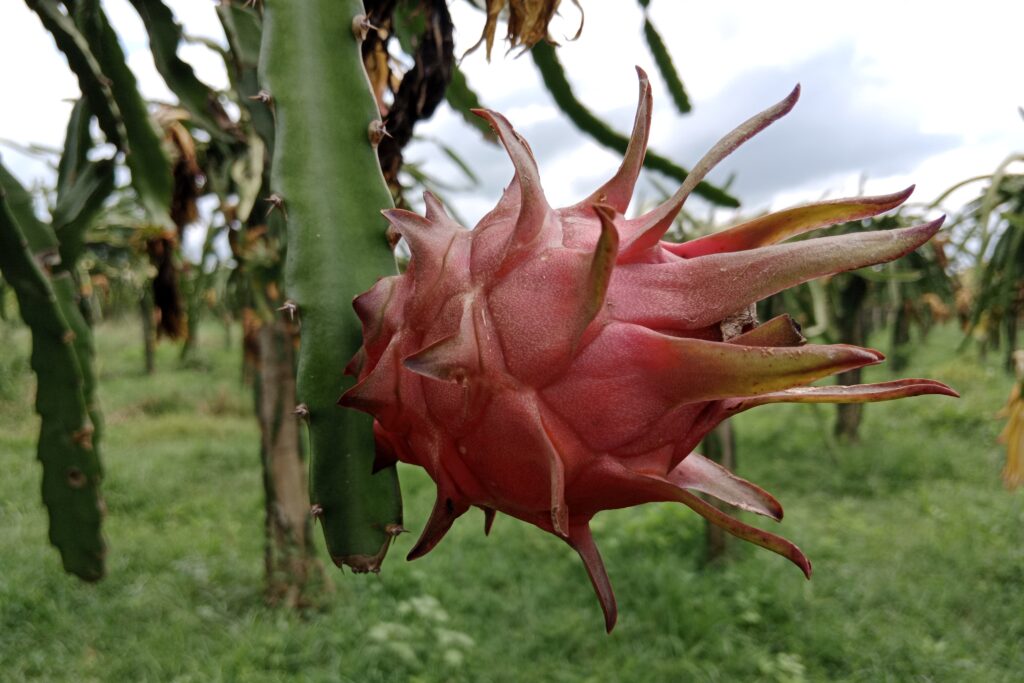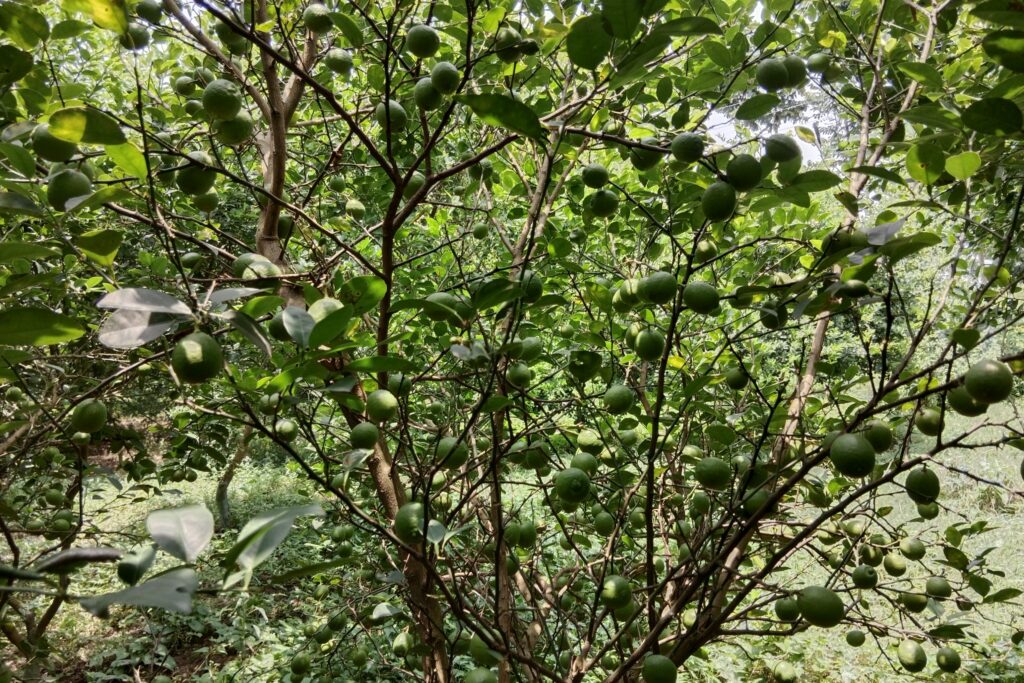Snake Gourd Farming Profit Per Acre
Snake gourd farming is an important horticultural practice that offers both nutritional and economic benefits. Cultivated primarily in tropical and subtropical regions, snake gourd is valued for its tender fruits, which are rich in vitamins, minerals, and dietary fiber.

The crop is well-suited to small and large-scale farming, requiring moderate investment and offering high returns when managed properly. With good agricultural practices, snake gourd cultivation not only ensures a steady market demand but also provides farmers with a profitable and sustainable source of income.
For agricultural entrepreneurs seeking a high-return venture, snake gourd farming profit per acre presents an exceptionally compelling opportunity. A detailed financial analysis reveals the strong earning potential of this crop, demonstrating that with a manageable total investment of approximately NRs. 49,000 farmers can achieve an estimated net profit of NRs. 111,000 for a single acre.
This outstanding performance translates to a remarkable Return on Investment (ROI) of around 226.5%, meaning that for every rupee invested, a profit of about Rs. 2.27 can be expected, solidifying its status as a highly lucrative agribusiness model.
Land Preparation
Land preparation is crucial to ensure a fine tilth and a well-drained seedbed for healthy root development. It begins with deep plowing (20–25 cm) using a moldboard plow to break the hardpan and bring the subsoil to the surface. After the first plowing, the soil should be left to weather for about a week, followed by 2–3 cross harrowings or rotavations to break down large clods. The field is then leveled using a wooden plank or laser leveler to ensure uniform water distribution and prevent waterlogging. Finally, after leveling, the field is marked and prepared for pits according to the recommended spacing.
Soil Type
Snake gourd can be cultivated in a wide range of soils, from sandy loam to clay loam, but well-drained sandy loam soil rich in organic matter is considered ideal. The crop performs best in slightly acidic to neutral soils with a pH range of 6.0 to 7.0, while poorly drained or saline soils are unsuitable for its growth.
Climatic Requirements
Snake gourd is a warm season crop that grows best in temperatures ranging from 25°C to 35°C, as it is highly sensitive to frost and cold weather. It requires moderate to heavy annual rainfall of about 1500–2000 mm but cannot tolerate waterlogging. For optimal growth and yield, the crop thrives best under full sunlight.

Major Cultivars
Popular cultivars are chosen for their yield, fruit length, and disease resistance.
| Cultivar | Description |
| CO 1 | Fruits are dark green and long. |
| CO 2 | High-yielding variety with long, slender fruits. |
| PKM 1 | Features very long (up to 2m), dark green fruits with soft flesh. |
| Sweta | Fruits are white, long, and thick. |
| TA 19 | A high-yielding variety with dark green fruits. |
| Local Landraces | Many farmers grow local cultivars adapted to specific regions. |
Propagation
Snake gourd is propagated sexually through seeds.
Seed Rate per Acre
The recommended seed rate for snake gourd is 1.5 to 2.0 kg per acre, and using good quality, certified seeds from a reliable source is essential to ensure better germination and higher yields.
Nursery Management
While direct sowing of snake gourd is common, raising seedlings in a nursery offers advantages for achieving a better plant stand. Seeds should be soaked in water for 12–24 hours to soften the hard seed coat and treated with a fungicide such as Thiram or Carbendazim (2 g/kg of seed) to protect against soil-borne fungi.
For sowing, protrays or polybags can be filled with a well-mixed medium of soil, sand, and well-decomposed farmyard manure or compost in a 2:1:1 ratio. Pre-soaked seeds are then sown at a depth of 2–3 cm, placing 1–2 seeds per cell or bag. Light watering should be done immediately after sowing, and partial shade provided until germination. Seedlings are ready for transplanting after 3–4 weeks, once they develop 3–4 true leaves.
Planting
a). Planting Season
Snake gourd can be grown in both Kharif and spring-summer seasons, with sowing done during June–July for the rainy season and from January–February under irrigated conditions for the spring-summer crop.
b). Spacing
A common spacing recommended for snake gourd cultivation is 2.0 meters between rows and 2.0 meters between plants.

c). Pit Preparation
For snake gourd cultivation, pits of 30 cm × 30 cm × 30 cm should be dug at the marked spots before planting.
d). Planting Method
In snake gourd cultivation, pits are filled with a mixture of topsoil and 10–15 kg of well-decomposed farmyard manure or compost, along with 100 g of neem cake and 1–2 handfuls of wood ash to serve as a bio-pesticide and a source of potassium.
For direct sowing, 3–4 seeds are placed per pit at a depth of 2–3 cm, and after germination, thinning is done to retain the two healthiest seedlings per pit. In the case of transplanting, seedlings raised in polybags are carefully placed in the center of the prepared pit, and the soil is gently firmed around them.
e). Number of Plants per Acre
At a spacing of 2 m × 2 m, snake gourd cultivation accommodates approximately 1,011 plants per acre.
Intercropping
Being a long-duration vine crop, snake gourd is well-suited for intercropping with short-duration crops such as radish, carrot, beetroot, coriander, spinach, or other leafy vegetables, which are sown between its rows during the first 1–2 months, providing farmers with additional income before the vines fully spread.
Irrigation
Irrigation for snake gourd should begin immediately after sowing or transplanting. During the vegetative stage, watering is needed every 3–4 days in summer and 7–10 days in winter, ensuring that waterlogging is avoided. The flowering and fruiting stage is critical, as moisture stress can cause flower drop and misshapen fruits, so adequate soil moisture must be maintained. Drip irrigation is highly recommended, as it saves 30–50% water, reduces weed growth, and allows for efficient fertigation.
Fertilizer and Manure
Always conduct a soil test to obtain precise fertilizer recommendations, as following a balanced nutrient regimen based on the results is essential for achieving optimal crop growth and high yield.
| Application Stage | Fertilizer Type | Dosage per Acre | Notes |
| Basal Dose (during pit preparation) | Well-decomposed FYM/Compost | 10-15 tons | |
| Chemical Fertilizers (e.g., Urea, SSP, MOP) | 40:60:40 kg of N:P₂O₅:K₂O | ||
| Biofertilizers | Azospirillum | 800g | Apply together during basal application. |
| Phosphorus Solubilizing Bacteria (PSB) | 800g | ||
| Potash Mobilizing Bacteria | 800g | ||
| Top Dressing (First Dose) | Chemical Fertilizers | 40 kg N and 20 kg K₂O | Apply 30 days after planting. |
| Top Dressing (Second Dose) | Chemical Fertilizers | 40 kg N and 20 kg K₂O | Apply during the flowering stage. |
Weed Control
Weeds compete aggressively with snake gourd plants for nutrients and water, particularly during the early growth stages. To manage them, 2–3 manual weedings should be performed during the first two months.
Additionally, applying organic mulch such as paddy straw or dried leaves, or using black plastic mulch around the base of the plants, helps suppress weeds and conserve soil moisture. Chemical control can also be employed, with pre-emergence herbicides like Pendimethalin applied after sowing but before weed seeds germinate, followed by manual weeding as needed.
Inter culture operation
Training
Training snake gourd vines is essential for producing straight, high-quality, blemish-free fruits. A bower system (pandal) should be used, erecting sturdy structures about 2 m in height with concrete or wooden posts and securing them with GI or plastic wires. Training the vines on the bower improves aeration and sunlight penetration, facilitates spraying and harvesting, and prevents fruits from touching the ground.
Pruning
Although not as critical as in other cucurbits, pruning can enhance yield by removing the initial 2–3 late-forming or misformed fruits. Additionally, pruning diseased and old leaves improves air circulation around the plants, contributing to healthier growth.
Flowering and Fruit Management
Flowering
Snake gourd is a monoecious crop, meaning that it produces separate male and female flowers on the same plant. Successful flowering and fruit set largely depend on pollination, with bees and other insects serving as the primary pollinators. Adequate insect activity is crucial for ensuring high fruit yield.
Fruit Setting
Poor fruit set in snake gourd can occur due to a shortage of pollinators or exposure to high temperatures. To overcome this, hand pollination can be performed. In the morning (6–8 AM), a male flower is plucked, its petals removed, and the anther is gently rubbed against the stigma of a female flower, which can be identified by the small ovary at its base. This method helps increase fruit set and overall productivity.
Fruit Thinning
Thinning excess fruits is beneficial for improving fruit quality. By removing some of the developing fruits, the remaining ones receive more nutrients and space to grow, resulting in larger, more uniform, and marketable fruits.
Pest and Disease Management
Common Pests
a). Fruit Fly
Fruit fly is one of the most destructive pests of snake gourd, as it lays eggs under the fruit skin and the maggots feed inside, causing significant damage. Management practices include using pheromone traps at a rate of 10 traps per acre, applying bait sprays made with Malathion mixed with jaggery (Gur), destroying infested fruits, and bagging young fruits with paper or polythene bags to prevent infestation.
b). Red Pumpkin Beetle
This pest damages seedlings, leaves, and flowers by chewing on them. Effective management involves dusting the plants with Malathion at 0.05% or spraying Chlorpyriphos at 2 ml per liter of water.
c). Aphids & Whiteflies
These pests suck sap from the plants and can transmit viral diseases. Control measures include spraying systemic insecticides such as Imidacloprid at 0.3 ml per liter of water or Acetamiprid at 0.2 g per liter of water.
Common Diseases
a). Powdery Mildew
This disease is identified by a white, powdery growth on the leaves of snake gourd. Management involves spraying Wettable Sulfur at 25 g per liter of water or Dinocap at 2 ml per liter at the first sign of infection to prevent its spread.
b). Downy Mildew
Downy mildew causes yellow angular spots on the upper surface of leaves, with purple fungal growth on the underside. Effective control includes spraying Mancozeb at 2 g per liter or Metalaxyl at 2 ml per liter of water.
c). Anthracnose
Anthracnose manifests as brown, sunken spots on both fruits and leaves. Management includes treating seeds before sowing and spraying Mancozeb at 2 g per liter or Carbendazim at 1 g per liter to protect the crop.
d). Mosaic Virus
Mosaic virus leads to stunted growth and a mosaic-like pattern on the leaves. Since it is transmitted by insect vectors such as aphids and whiteflies, controlling these pests is essential, along with removing and destroying infected plants to prevent further spread.
Harvesting
Harvesting typically begins 60-80 days after sowing, though this timing depends on the specific variety and growing season. Fruits must be harvested at the tender and immature stage while they are still green, the skin is soft, and the seeds are tender; avoiding overripe fruits is critical as they become fibrous, sour, and inedible.
Due to the rapid maturity of the fruits, harvesting should be performed frequently, every 2-3 days. Using a sharp knife or secateurs, the fruit is carefully cut with a short stalk attached, as pulling or twisting can easily damage the vine.
Yield
Under proper management practices, snake gourd can produce an average yield of 8,000 to 10,000 kg per acre.
Cost of Investment per Acre for Snake Gourd
| S.N. | Categories | Cost (NRs.) |
| 1 | Land Preparation | 15,000 |
| 2 | Seed | 1,000 |
| 3 | Nursery Management | 3,000 |
| 4 | Planting | 2,000 |
| 5 | Fertilizers and Manure | 6,000 |
| 6 | Irrigation | 5,000 |
| 7 | Weed Control (pre & post-emergence) | 4,000 |
| 8 | Pest & Disease Control | 5,000 |
| 9 | Harvesting | 3,000 |
| 10 | Miscellaneous Costs | 5,000 |
| Total Cost | 49,000 |
Income per Acre from Snake Gourd Farming
| Parameter | Value | Rate (NRs.) | Amount (NRs.) |
| Estimated Yield | 8,000 Kg | 20 / Kg | 160,000 |
Analysis of Snake Gourd Farming Profit Per Acre
| Description | Calculation | Amount (NRs.) |
| Total Income | 8,000 Kg × NRs. 20 | 160,000 |
| Total Investment | 49,000 | |
| Net Profit | 160,000 – 49,000 | 111,000 |
| Return on Investment (ROI) | (111,000 / 49,000) × 100 | ~226.5% |
The profit analysis shows that snake gourd farming can be highly profitable. With a total investment of NRs. 49,000, the estimated net profit is NRs. 111,000 per acre. This represents a very strong Return on Investment (ROI) of approximately 226.5%, meaning for every rupee invested, the farmer can expect to earn a profit of about Rs. 2.27.
Crop Calendar of Snake Gourd Farming
| Month (Approx.) | Kharif / Rainy Season Crop (Sowing: June-July) | Spring-Summer Crop (Sowing: Jan-Feb) | Key Activities & Operations |
| Pre-Planting (1 Month Before Sowing) | May | December | Land Preparation: Deep plowing, harrowing, leveling. Prepare pits (30x30x30 cm). Input Collection: Procure seeds, fertilizers (FYM, NPK), and biofertilizers. |
| Sowing/Transplanting | June – July | January – February | Nursery Sowing: Sow treated seeds in protrays/polybags. Direct Sowing: Sow 3-4 seeds per pit. Transplanting: Shift 3-4 week old seedlings to the main field. |
| Early Growth Stage (0-30 Days) | July – August | February – March | Irrigation: Light and frequent irrigation to establish plants. Thinning: Retain 2 healthy seedlings per pit. Weeding: First manual weeding. Basal Dose: Apply full FYM and basal NPK dose during pit filling. |
| Vegetative Stage (30-60 Days) | August – September | March – April | Training: Begin training vines onto the bower/pandal system. Top Dressing (1st): Apply 40 kg N & 20 kg K₂O per acre 30 days after planting. Weeding: Second manual weeding and mulching. Pest Control: Monitor for red pumpkin beetles and aphids. |
| Flowering & Fruit Set (60-80 Days) | September – October | April – May | Top Dressing (2nd): Apply second dose of 40 kg N & 20 kg K₂O during flowering. Pollination: Ensure bee activity; practice hand pollination if needed. Disease Control: Monitor for powdery and downy mildew. Fruit Fly Management: Set up pheromone traps and begin fruit bagging. |
| Harvesting (60-110 Days) | October – November | May – June | Harvesting: Begin harvesting 60-80 days after sowing. Frequency: Harvest tender, green fruits every 2-3 days. Method: Use a sharp knife to cut the fruit with a short stalk. |
| Post-Harvest | November Onwards | June Onwards | Field Sanitation: Collect and destroy leftover fruits and vines to break pest cycles. Soil Preparation: For the next crop, incorporate leftover organic matter. |
Also Read: Bottle Gourd Farming Profit Per Acre
Also Read: Sponge Gourd Farming Profit Per Acre
Sources
Food and Agriculture Organization (FAO)
University of California Agriculture & Natural Resources (UC ANR)
European Plant Protection Organization (EPPO)
Punjab Agricultural University (PAU)
Tamil Nadu Agriculture University (TNAU) – Agritech portal
Indian Council of Agricultural Research (ICAR)
Nepal Agricultural Research Council (NARC)
U.S. Department of Agriculture (USDA).
Ministry of Agriculture and Livestock Development (Nepal)
Disclaimer: This crop farming profits assume optimal conditions. Actual results may vary depending on climate, market prices, and farm management practices.



